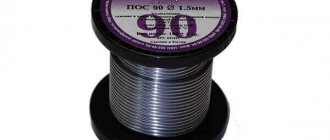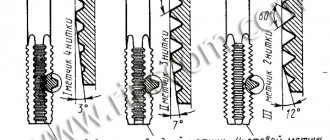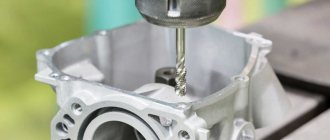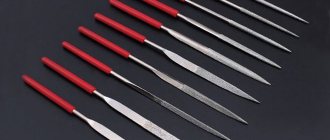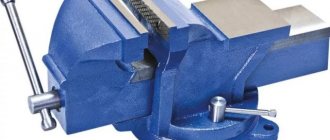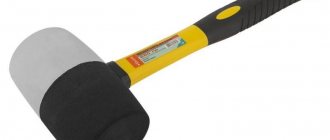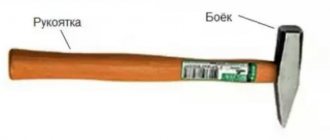Types of polishes
The most common body polishing agent is car polish. When the substance is applied to the car body, a layer is formed that gives the paint a characteristic shine and masks traces of scratches and abrasions. After removing excess paint, a thin film remains on the paint layer, which protects the car body from dirt, moisture and sunlight.
Abrasive polishes
The grinding properties of the components of such auto polishes enhance the effect that is achieved after using the product. Such compositions are used for polishing the body or for removing old traces of damage from it.
The use of abrasive paste when polishing a car body has some features:
- Due to the presence of abrasive elements, there is a possibility of damage or complete removal of the varnish coating or even one or more layers of paint.
- To enhance the effect of abrasive paste for manual polishing of a car, the owner can use a grinding machine. However, the risk of damaging the paintwork increases several times.
- Before polishing, it is advisable to repair all chips and scratches on the car body.
Abrasive polishing agents are not recommended for cleaning cars with metallic paint, as a matte effect may appear on the top layer of varnish.
Despite the advantages of abrasive paste, its frequent use is not recommended due to the risk of damaging the paint layer.
Wax polishes
Such polishing products are liquids with the addition of wax. Car polishing wax makes the car's finish shiny, but its effect is short-lived. The effect of using the highest quality liquids containing wax disappears after 2-3 car washing sessions. Often, car enthusiasts use wax car polishes when preparing a car for sale, improving its appearance.
Synthetic polishes
Manufacturers, in order to increase the effect of using care products, add synthetic elements to them. There are several types of such funds:
- Cleaning and restorative car polishes are designed primarily to remove abrasions and traces of oxidation. After using this type of body polish, it is necessary to apply a substance with a protective composition to the paintwork of the car to prevent oxidation.
- The most popular type of synthetic polishes is polymer. They protect the car well from external factors that harm the body coating, such as ultraviolet rays or salts. The effect of use can last for 2-3 months even after several washes. Their disadvantage is their high cost and difficulty in processing.
- Silicone polishes for car bodies are similar in their effect and principle of operation to wax versions. They are cheap, durable and easy to apply.
Cleaning and restorative polishing compounds do not harm car bodies painted in metallic and pearlescent colors.
Selection of polishing paste at different stages
Abrasive polishing is the most difficult and critical stage of the entire process. It consists of removing the thinnest layer of paintwork using special abrasive pastes, which are selected according to their grain size.
Compositions with fine, medium and coarse grain sizes are available for sale. For example, to restore minor body defects, it is recommended to use fine-grained compounds. If there are a large number of abrasions and scratches on the car, it is necessary to use coarse abrasive pastes.
[goo2]
3M Polishing Compounds and Wheels
As for protective polishing, it can be Teflon, wax or epoxy. Epoxy-based polishes provide the longest possible protection for your car.
Thus, the choice of polishing paste for each stage of processing is determined solely by the condition of the body paint. There is a huge range of polishing pastes on the market in different price categories. A special place is occupied by 3M compounds, which are distinguished by their high quality and affordable price. Manufacturers of these pastes value their reputation, so they carefully develop compositions suitable for various types of processing.
To carry out the polishing procedure, it is not enough just to purchase special compounds. It is also necessary to know the sequence of the process, consisting of the preparatory, main and final stages.
How to make your own polish
Every car enthusiast can make polish for a car body at home. First you need to determine the type of substance needed by the car owner. If you have decided to make your own composition with abrasive properties, first of all, acquire a grinding component. Most often, the abrasive is produced independently by burning paint containing chromium or ammonium dichromate.
When ammonium dichromate is burned, hydrochloric acid evaporates after combustion.
Next, the binder composition is prepared. For this you need the following ingredients:
Wax polish can be made at home using toothpaste, beeswax, turpentine or vegetable oil. The resulting oil composition after using these ingredients must be mixed with hot wax.
Forms
In the assortment of automobile stores there are polishes made in the following forms:
- The most common are liquid products. Such polishes are extremely uneconomical. It is recommended to purchase liquid polish with a high silicone content.
- Hard polishes are popular among car enthusiasts because they allow you to apply a thick layer of the substance. This property gives a more vibrant color and high shine after use. But it is important to know how to apply such polishing agents correctly.
- Polymer polishes in the form of a cream contain wax and silicone. They are distinguished by a good price-quality ratio, as well as ease of use for manual polishing.
- Aerosol car polishes are easy to use and apply. However, the effect of such drugs is often very low. By analogy with liquid polishes, it is recommended to purchase aerosols with a high silicone content.
Popular brands
Given the variety of body polishing products, choosing the right polishing agent can be difficult. Below is a list of the most popular products:
- In the rating of silicone car polishing products, it is worth noting Synthetic Sealant Meguiars. Complex polymers in the polish form a protective layer, which also protects the car's paintwork from scuffs.
- Another synthetic product, Extreme Nanotech from Turtle Wax, can buff out scratches on your car. This product is suitable for polishing black and colored cars.
- Among wax polishes, 3M Synthetic Wax Protectant paste stands out. It hardens slowly, creating a protective layer that protects against scratches. To polish your car at home, use Turtle Wax Color Magic, a polish for black cars. A pencil is included.
- One of the well-known abrasive pastes for polishing car bodies is the domestic GOI paste, which is sold in most hardware stores. You can also note the Japanese-made Wilson polish, which can be used to polish even the surface of glass, and products manufactured by 3M. All of these products are suitable for polishing a dark-colored car. After proper use, a characteristic shine is noticeable on the body.
Selecting a professional polish is not an easy task. To give a car a spectacular appearance, the car owner must, in addition to selecting a polish, be able to use such products correctly.
Choosing the best paste for polishing car headlights
Hi all! As practice shows, high-quality headlight polishing paste provides a long-lasting and very beneficial effect for the optics of the vehicle. At the same time, not everyone knows what is better to buy, what kind of polish to choose and how to apply it with your own hands.
I’ll say right away that I won’t talk about the process of polishing glass and plastic headlights today. To do this, you can look at the link, where the issue of polishing headlights with your own hands in a garage or at home has already been discussed.
Today we will discuss the means themselves, their varieties, and also introduce you to the most popular solutions available on the Russian market.
What type of abrasive paste is best?
Both types of pastes have their uses, so it is debatable which is better. It all comes down to what is more convenient for you. Many professionals choose pastes with non-reducing micro-abrasives for complete control over the polishing process. For example, 99% of Meguiars polishing pastes are SMAT. In turn, DAT pastes are widely used due to their versatility, since most often, only one paste is enough to obtain the desired results.
Let's look at the main pros and cons of different types of polishing pastes.
What is important to know
It's no secret that some even use sandpaper to restore the surface of the head or rear optics of a car. On Drive2 you can find many similar stories and instructions.
Car optics need constant protection from negative influences from the environment, roads and other road users. The outer surface is constantly exposed to dust, dirt, mechanical damage, chemicals, etc. To clean it and restore its previous transparency and light transmittance, you need to take an appropriate care and restoration kit. The market range is huge, which is why many cannot decide what is best for them to use.
Some people buy a special 3M type kit, which already contains everything needed for polishing. Others use toothpaste, others use goyim toothpaste, and still others buy branded products that have received the most positive reviews.
The price of pastes varies, as does their composition. It’s quite difficult to say unequivocally which one is the best. Some believe that only abrasive, and diamond, paste is suitable for such tasks. Others categorically refuse the idea of using any abrasive for fear of damaging the headlight material.
To make the right choice, you need to consider several points:
- Material of manufacture. Some compounds are intended only for glass headlights, others exclusively for plastic ones. But there are also universal solutions;
- Severity of damage. There are chips and deep scratches that pastes cannot save from. But there are also simply cloudings, yellowing, minor scratches and abrasions;
- Matching the specific headlight. If you can find out which polishing agents are suitable for your type of optics, that would be great.
The polishing process itself is done with your own hands or with a grinder. In the latter case, it is better to use a device in which the speed is regulated.
You can process glass headlights yourself without fear of any special consequences. But when working with plastic, it is better to contact a car service. The only downside is that the price of the service is quite high. Both in Minsk and in Moscow. But there is a minimum risk of harming the car. What do you think about this? Leave feedback.
Polishing wheels
You can vary the impact by using more or less hard circles. You can start with one, polish, then switch to another wheel.
The material as well as the design of the polishing wheels has a big impact on the performance of the pastes and the results obtained.
Polishing pads are made from various materials. They come in wool, foam, and microfiber. Microfiber and wool are the toughest because the individual fibers provide a larger surface area for polishing materials to stick to. Wool is the most aggressive and leaves micro-scratches. Microfiber is generally less aggressive than wool, but more aggressive than foam. Foam circles are generally the least aggressive. You can read more about foam rubber and wool circles and their use in the article “woolen vs foam rubber circles.”
Popular solutions
Considering what optics becomes before and after using various products and pastes, there are several key categories and types of products.
Based on popularity and effectiveness, such pastes are the most popular.
- Dental. You will be surprised, but toothpaste has excellent polishing properties. Suitable for plexiglass and plastic products with minor wear. It is applied extremely simply, the paste is rubbed with ordinary rags or towels. It is recommended to gradually rub in the toothpaste for 10-20 minutes, and then rinse off the excess with water and wipe dry;
- GOI. Chromium-based grinding paste. It is distinguished by its rich green color and dense structure. Suitable for polishing bodywork, headlights and even precious stones. The paste has gained wide popularity and is used in a wide variety of areas. It is most convenient to apply using a grinder, after first applying paste to it or to the headlight itself. Residues are removed with water and dry, clean rags;
- Special means. Here we are talking about branded pastes produced by well-known companies. They are more expensive than previous options, but have better efficiency. There are professional and amateur products. The first ones are used in car service centers, they are expensive, but last longer.
You can find many videos online that show how headlights look before and after treatment.
How to apply headlight polish?
Before applying this paste to the head optics, you need to carry out a number of preparatory measures. First, you should thoroughly wash and then degrease both headlights using white spirit or anti-silicone. Then the unnecessary areas are covered with masking tape. These are the bumper, radiator grille and fender edge. The hood can be raised during the operation (so as not to waste time taping it).
Next, the surface is sanded. This should be done using fine-grained sandpaper. You need to treat the headlight by regularly wetting it with water. The thickness of the sandpaper should be P1200-1500. Before sanding, it is recommended to soak it in water for five minutes. When processing, you need to make crosswise movements. You need to clean with short movements to avoid large scratches. Wash off any remaining plastic removed with plenty of water.
After this, the restoration paste itself is applied. It must be applied to the polishing wheel. The latter should be clean and slightly moistened (so that the paste does not dry out prematurely). Then turn on the sander and hold the wheel strictly parallel to the area in order to avoid streaks. You need to start working at low speeds so that the paste is evenly distributed over the headlight. The rotation speed should not exceed 2.5 thousand revolutions per minute. At higher temperatures the material will heat up. This is harmful both to the plastic and to the material itself (it will simply dry out). Upon completion of work, you need to rinse the surface with water and remove the masking tape. That's it, the work on restoring the car's optics is completed.
Branded pastes
Let's make a small rating of the most popular and common polishing pastes that can be used to process plastic and glass surfaces of headlights. Some of them also polish windshields, but here you should take a more careful approach to the issue of choice, studying the purpose and capabilities of a particular paste.
- Runway. Their product is called Headlight Polish. Silicone-free paste for easy application. You can process it by hand or with a sander. Costs about 350 rubles, the effect lasts 2-3 weeks;
- Lavr. Russian company offering the product Polish Restorer. Sold as a set costing 250 rubles. The composition contains a spatula, polish and several sanding papers. In addition to grinding, it creates a protective film due to wax and silicone in the composition;
- Abro. The paste is called HR230. Suitable for plastic optics only. A tube will cost 300 rubles. Excellently restores transparency and protects the surface. But you need to use it at least once every 3 months;
- Saphire. Good manufacturer of head lamp polish. It literally costs 160 rubles. It is recommended to order only through an authorized dealer. Restores transparency, does not require the use of a grinder;
- Sonax. Removes scratches well and is suitable for treating surfaces made of plexiglass. Can also be used for glass optics. Excellent German quality.
What good pastes for working with automotive optics do you know? What else would you include on this list, or what tools would you cross off from it, based on personal experience? Be sure to write, it will be interesting and useful.
Of course, the list of good pastas does not end there. The market range is huge. I have named only those that are popular and that I have encountered personally and received a positive impression.
Let's say goodbye. Thanks everyone for your attention!
Subscribe, leave your comments and ask relevant questions!
(
2 ratings, average: 5.00 out of 5)
Polish for black car
If the body of your car is painted black, it looks very presentable and respectable. Despite the popularity of this color as the base and only one on the body, not all drivers can boast of its shine and beautiful appearance. Any paint, even the highest quality, fades over time, small scratches and cracks form on it, which contributes to the appearance of dullness. This state of affairs does not suit many drivers, and they begin to look for a quality polishing agent.
Black car polishing
It is worth noting that not every substance is suitable for a black car - some are quickly washed off.
In addition, many people want to purchase a polish with a coloring effect. Such a remedy:
- removes surface dullness and guarantees shine;
- saturates black color and prevents it from fading;
- creates a protective film that does not allow the negative impact of precipitation and chemicals.
- chipped paint;
- small scratches and cracks;
- faded and worn areas;
- "webs" or "holograms".
Polishing Features
One of the main problems that owners of black cars face is cobwebs. This collection of small scratches, making the surface matte, is also especially noticeable on glossy and metallic finishes. Its existence highlights the external defects of the car, making it less respectable. For this reason, your car must be maintained regularly and with special requirements.
For example, it is unacceptable to use an uncleaned cloth while polishing - the dust contained on it can act as an abrasive that prevents the car from giving a shine. To polish dark cars, use clean, soft cloths or rags.
To regularly protect the surface of your car, you can purchase protective compounds that will temporarily prevent exposure to precipitation and chemicals. It is worth remembering that sooner or later you will still have to do more thorough work:
- contact the service center;
- Use a polishing machine or special mixtures to polish the surface of the car yourself.
Types of funds
If your car is in good condition, polishing it will not take much of your time, even if you don’t have a polishing machine. You can find budget-friendly hand polishes that will remove minor imperfections. These include, for example, Willson EPX - a leading product among owners of dark cars. Among its advantages, according to car enthusiasts, are a strong shine that lasts throughout several washing procedures, excellent restoration of black color, and ease of application. Of course, such a polish will not provide very long protection, but the speed of application contributes to its popularity.
Black car polishing
Other mixtures that are similar in characteristics and parameters to Willson EPX include:
- Turtle Wax Color Magic. It is a color enriched polishing agent with good masking effect. Fills small cracks with pigments that align the reflective plane. The product comes with a pencil that can be used to mask deep chips;
Turtle Wax Color Magic Willson PRX polish. Suitable for cars of any color. Contains carnauba wax. It adds depth to the color and provides a “wet shine”.
Willson PRX Polish
These are in the same price range and are often used as an alternative to the above Willson EPX.
Color enriched
Their key feature is the presence of colored pigments, which give the body a more vibrant appearance. There are polishing pastes for different body shades. But they operate on the same principle. For example, on a black car they make the paintwork deeper and richer.
White color-enriched polish will return an old car to its snow-white appearance. This composition also perfectly hides scratches and other minor defects on the body. However, as operating experience shows, this polishing paste has a shorter lasting effect than the previous one. As for the area of application, this composition is universal. Color enriched polishing paste is suitable for both plastic and metal. At the same time, it does not create any visible transition when processing, for example, plastic bumpers and iron wings.
Stages of the polishing process
If your car is relatively new, then the product will be most effective for it. To perform the polishing process, you need:
- wash the car with a special composition (car shampoo) - it removes the oxidized layer of paint. After this work, existing defects are easy to identify;
- carry out abrasive treatment - this is required for serious and deep scratches and is carried out either with a polishing machine or with abrasives. To begin with, coarse abrasive cleaning is carried out, and as the surface is leveled, the grain size of the abrasive agents decreases, helping the surface acquire a shine;
Abrasive surface treatment before applying polish to remove micro-scratches - this can be done with a special pencil included in the composition, or by polishing. For dark cars, it is important to remove micron scratches called “holograms”;
To remove micro-scratches with a pencil, cover with a protective polishing layer - first, you need to apply protection against ultraviolet rays and fading to the car, and then treat it with polish again or apply liquid Teflon.
Removing micro-scratches with a pencil
A polish with a liquid glass effect works best on the surface. Its protection period is about a year.
If you polish the surface yourself, pay attention to the severity and visibility of existing defects. The choice of method for giving the surface a presentable appearance depends on them. The imperfections are best visible after washing and degreasing the body. Afterwards you can clean it with clay and abrasives. Use rags, flannel pieces of fabric or napkins as auxiliary materials to avoid damaging the surface.
Remember: regular and high-quality treatment increases the likelihood of a long service life of the paintwork.
Composition of polishing paste
Car care products such as polishing pastes usually do not contain silicones or parabens. This allows you to avoid greasy shine on the surface of the glass, and also easily wash off the paste with water after finishing work. Their absence also reliably protects against the appearance of streaks on the glass even in sunny weather.
One of the important components included in this type of polish is cerium oxide. It makes the impact on the surface being treated as effective as possible, removing unevenness at a deeper level. Enhanced action reduces polishing time, so before purchasing a paste, it is important to make sure that cerium oxide is listed in its composition.
It is advisable to check which substance is abrasive. For example, diamond chips, which have good abrasive properties, can be used for these purposes. Another option is boron nitrite.
Fats are usually used as a binder, but in very limited quantities.


